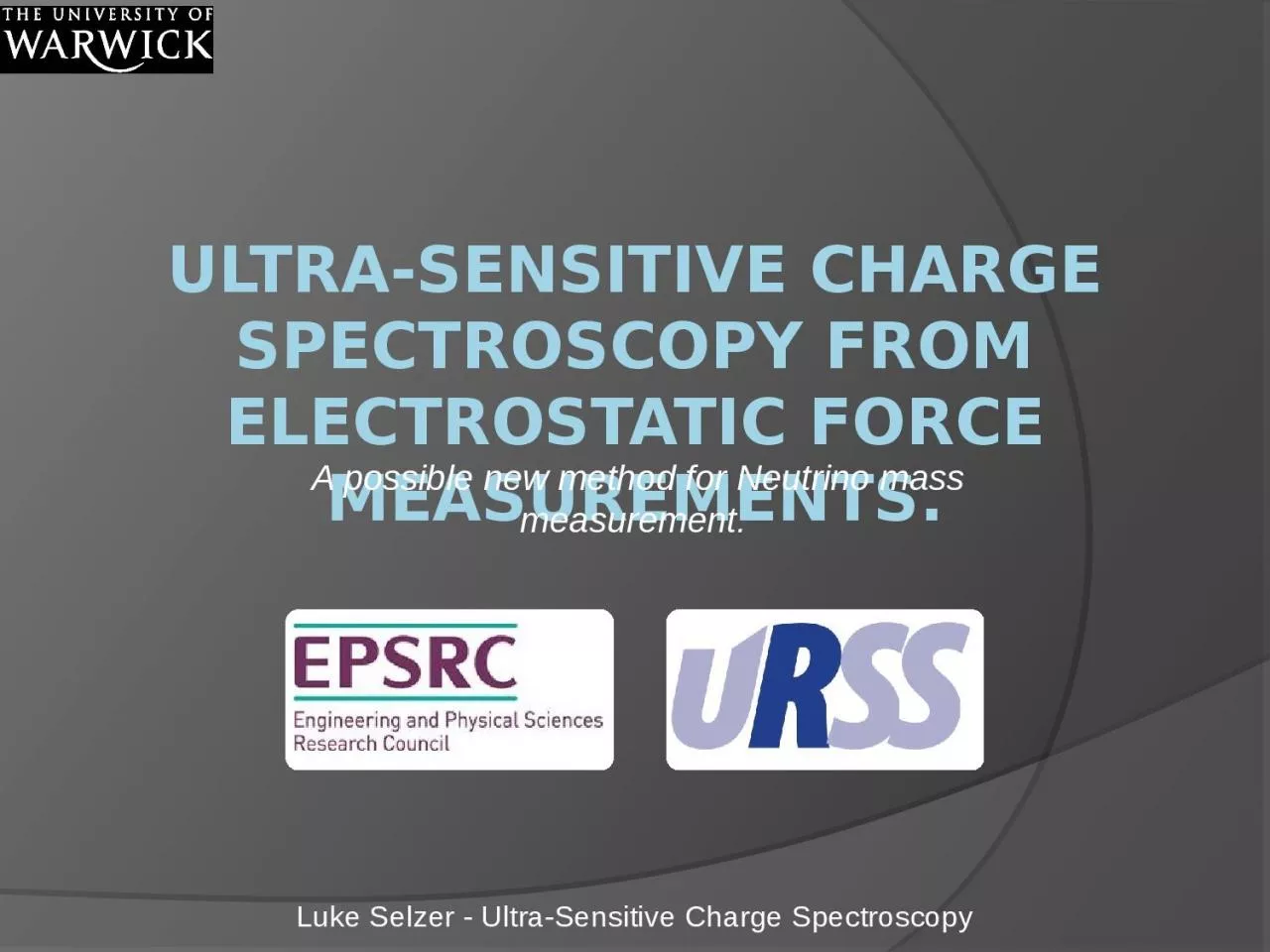

A possible new method for Neutrino mass measurement Luke Selzer UltraSensitive Charge Spectroscopy Introduction We have already built a working in air prototype Capable of very accurate voltage charge and force measurement ID: 1025600
Download Presentation The PPT/PDF document "Ultra-sensitive Charge Spectroscopy from..." is the property of its rightful owner. Permission is granted to download and print the materials on this web site for personal, non-commercial use only, and to display it on your personal computer provided you do not modify the materials and that you retain all copyright notices contained in the materials. By downloading content from our website, you accept the terms of this agreement.
1. Ultra-sensitive Charge Spectroscopy from Electrostatic Force Measurements.A possible new method for Neutrino mass measurement. Luke Selzer - Ultra-Sensitive Charge Spectroscopy
2. IntroductionWe have already built a working, in air, prototype.Capable of very accurate voltage, charge and force measurement.Our aim was to complete construction on a vacuumed version.Test Vacuum stability.Use new setup to study β- Decay in the 63Ni sample.Luke Selzer - Ultra-Sensitive Charge Spectroscopy
3. β- Decay Theory Luke Selzer - Ultra-Sensitive Charge SpectroscopyFig 1. Quark level Feynman diagram of a β – decay.The chosen β- Decay candidate was 63Ni:Main feature of β- Decay is the electron and electron anti-neutrino production:
4. β- Decay Energy SpectrumEnergy distribution for the electron emissions.Described by the “Fermi Function”.Important to notice there is a cut off energy.Luke Selzer - Ultra-Sensitive Charge SpectroscopyFig 2. Example of a β- Decay electron energy spectrum
5. The Kurie PlotPlot of linearized version of β- Decay energy spectrum.With non-zero neutrino mass the plot becomes non-linear.Occurs at high electron energy values. Luke Selzer - Ultra-Sensitive Charge SpectroscopyFig 3. Kurie plot demonstrating effect of non-zero neutrino mass.
6. Basic PrincipleVane setup in Vacuum.Vane undergoes β- Decay.Electrons are emitted.Vane becomes positively charged.Reaches an equilibrium comparable to the upper electron energy bound. Luke Selzer - Ultra-Sensitive Charge SpectroscopyFig 4. Photograph of floating dummy Nickel sample in the current experiment.
7. Measuring the Vane VoltageVane is kept in place by a red laser and the diode array.Electrostatic correction force is controlled by the diodesVane held stationary by steadily increasing supply voltage.Luke Selzer - Ultra-Sensitive Charge SpectroscopyFig 5. Schematic diagram of the rotation control system.
8. Vane Voltage RampElectrons emitted ramp charge on vane.Vane becomes highly charged and fewer electrons are emittedEventually only high energy electrons are able to escape.Luke Selzer - Ultra-Sensitive Charge SpectroscopyFig 6. Graph modelling the proposed negated voltage ramp on the vane due to electron emission.
9. Luke Selzer - Ultra-Sensitive Charge SpectroscopyOutput data from the experiment β- Decay spectrumKurie PlotDifferential of the output data produces the energy spectrumLinearized version of the energy spectrum should produce a kurie plotData Analysis
10. The Current Experimental Set UpNeodymium magnetic suspension system .Infrared Laser control system.Height and Rotation.Luke Selzer - Ultra-Sensitive Charge SpectroscopyLevitation Control SystemLevitation ZoneRotation ControlDiodes and LaserRotation control electrodeFig 7. Photographs taken of the current set up.
11. Levitation SystemInfrared laser strikes top edge of the plate.A feedback system is set up with the control coil.Magnetic field strength is continuously adjusted.Vane levitated due to ferromagnetic properties.Vane is balanced in an unstable fixed point.Luke Selzer - Ultra-Sensitive Charge SpectroscopyFig 8. Simulation of magnetic field lines supporting the ferromagnetic Vane.
12. Current Rotation ControlElectrostatic rotation control.HT D.C. voltage applied to electrode.Luke Selzer - Ultra-Sensitive Charge SpectroscopyFig 8. Front view of the electrostatic field.Fig 9. Top view of the electrostatic field .The Nickel vane aligns with electrode.Nickel is still levitated by magnetic field only.
13. CalibrationExternal Laser applied to vane using a square wave form.A voltage change is displayed, the amplitude linearly corresponds to the Laser’s photon force.Order of magnitude of 5 x 10 -12 N.Pico Newton force measurement.Luke Selzer - Ultra-Sensitive Charge SpectroscopyFig 10. output data from a laser calibration run.
14. The New Set UpTwo height control lasersAllows free rotation through 360 degreesAllows us to see preferred positionsVacuum system.Luke Selzer - Ultra-Sensitive Charge SpectroscopyFig 11. Photograph of new height control system to be placed into the vacuum system.
15. New Rotation Control SensitivityLuke Selzer - Ultra-Sensitive Charge SpectroscopyFig 13. Sensitivity plotted against angle of vane at varying electrode distances. Fig 12. Simulation cross section of new rotation control setup with contours depicting the electric field values.
16. …Finally.Current progress:Prototype built and tested.Calibrated.Vacuum system is built undergoing vacuum testing.Future applications:Detailed conduction studies of various gases.Precise capacitance measurement.Large range of experiments requiring sensitive force measurement. Luke Selzer - Ultra-Sensitive Charge Spectroscopy
17. Thanks to Yorck and the Electronics Workshop.Any further questions?Luke Selzer - Ultra-Sensitive Charge Spectroscopy